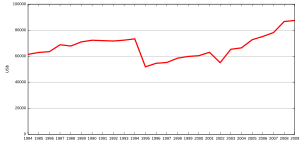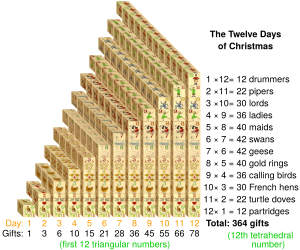Christmas Price Index facts for kids
| Christmas Price Index (US$) | |||
|---|---|---|---|
| Year | Christmas Price Index |
Δ% in CPI | True Cost of Christmas |
| 1984 | $12,623.10 | +1.44% | $61,318.94 |
| 1985 | $12,765.99 | +1.13% | $62,818.92 |
| 1986 | $12,920.25 | +1.21% | $63,402.22 |
| 1987 | $13,871.75 | +7.36% | $68,740.80 |
| 1988 | $13,785.63 | −0.62% | $67,745.74 |
| 1989 | $14,598.78 | +5.90% | $70,961.21 |
| 1990 | $15,231.72 | +4.34% | $72,205.12 |
| 1991 | $15,455.79 | +1.47% | $71,907.19 |
| 1992 | $15,581.96 | +0.82% | $71,618.71 |
| 1993 | $15,760.70 | +1.15% | $72,258.42 |
| 1994 | $15,944.20 | +1.16% | $73,258.42 |
| 1995 | $12,481.65 | −21.72% | $51,764.94 |
| 1996 | $13,195.86 | +5.72% | $54,478.36 |
| 1997 | $13,343.86 | +1.12% | $55,086.26 |
| 1998 | $14,214.90 | +6.53% | $58,405.09 |
| 1999 | $14,940.17 | +5.10% | $59,719.33 |
| 2000 | $15,210.22 | +1.81% | $60,307.18 |
| 2001 | $15,748.81 | +3.54% | $62,935.17 |
| 2002 | $14,558.05 | −7.56% | $54,951.31 |
| 2003 | $16,885.28 | +15.99% | $65,264.28 |
| 2004 | $17,296.91 | +2.44% | $66,334.46 |
| 2005 | $18,348.87 | +6.08% | $72,608.02 |
| 2006 | $18,920.59 | +3.12% | $75,122.03 |
| 2007 | $19,507.25 | +3.10% | $78,100.10 |
| 2008 | $21,080.10 | +8.06% | $86,608.51 |
| 2009 | $21,465.56 | +1.83% | $87,402.81 |
| 2010 | $23,439.38 | +9.20% | $96,824.29 |
| 2011 | $24,263.18 | +3.50% | $101,119.84 |
| 2012 | $25,431.18 | +6.1% | $107,300.24 |
| 2013 | $27,393.18 | +7.70% | $114,651.18 |
| 2014 | $27,673.21 | +1.00% | $116,273.06 |
| 2015 | $34,130.99 | +0.6% | $155,407.18 |
| 2016 | $34,363.49 | +0.7% | $156,507.88 |
| 2017 | $34,558.65 | +0.6% | $157,558.00 |
| 2018 | $38,926.03 | +11.2% | $170,362.26 |
| 2019 | $38,993.59 | +0.17% | $170,298.03 |
| 2020 | $16,168.14 | -58.5% | $105,561.80 |
| 2021 | $41,205.58 | +5.7% (+64.6%) | $179,454.19 |
The Christmas Price Index is a fun and unusual way to track how much things cost over time. It's like a special list kept by a U.S. bank called PNC Wealth Management. This index looks at the prices of all the gifts mentioned in the famous Christmas song, "The Twelve Days of Christmas".
Contents
What is the Christmas Price Index?
This index was created by a bank's main economist as a funny way to measure how prices change. Think of it like a "shopping basket" of specific items. Economists often use these baskets to see how much things cost each year. This helps them understand inflation, which is when prices generally go up over time.
The Christmas Price Index uses the gifts from "The Twelve Days of Christmas" as its special shopping basket. These gifts include:
- A partridge in a pear tree
- Two turtle doves
- Three French hens
- Four calling birds
- Five golden rings
- Six geese
- Seven swans
- Eight maids
- Nine dancing ladies
- Ten leaping lords
- Eleven pipers
- Twelve drummers
The tradition says that buying these gifts starts on December 25th and finishes on January 5th.
How is the Index Calculated?
PNC calculates two different costs: the "Christmas Price Index" and "The True Cost of Christmas."
- The Christmas Price Index is simply the total cost of buying one of each item listed in the song.
- The True Cost of Christmas is much higher! It's calculated as if you bought all the gifts mentioned in the song, exactly as they are given over the twelve days. For example, on the first day, you get one partridge. On the second day, you get two turtle doves and another partridge. This means by the end, you'd have 12 partridges, 22 turtle doves, and so on, for a grand total of 364 items!
Where Do the Prices Come From?
PNC gets the prices for each item from different places:
- The pear tree price comes from a local plant nursery.
- Prices for the partridge, turtle doves, and French hens are based on what a zoo charges.
- The cost of a canary from a pet store is used for the "calling bird."
- A jewelry store helps set the price for the golden rings.
- The cost for the maids is based on the lowest legal wage in the United States.
- A dance company helps estimate the pay for the ladies dancing.
- A ballet company gives an estimate for the leaping lords (male ballet dancers).
- The cost for the drummers and pipers comes from a musicians' union.
What Does the Index Show?
Just like other fun economic measures, such as The Economist magazine's Big Mac Index (which compares the price of a Big Mac burger around the world), the Christmas Price Index actually tells us interesting things about the economy.
Generally, the index shows that prices for services (like hiring dancers or musicians) have gone up a lot. But prices for goods (like birds or rings) have mostly stayed the same or even gone down. For example, the cost of hiring the ladies and lords has increased by over 300 percent! After the dancers, the seven swans are usually the most expensive item because it's hard to predict when swans will breed, making their supply uncertain.
The cheapest item in the index is usually the partridge. In 2008, you could buy one for about $20. Overall, the prices in this index tend to go up and down in a similar way to the standard United States Consumer Price Index, which tracks the cost of everyday goods and services.
The survey also checks how much it costs to buy these items online. It's usually much more expensive because of shipping costs. However, if you bought each item from the cheapest possible seller, the total cost would be less.
Why Some People Question the Index
Some people have pointed out a few things about the Christmas Price Index:
- Not all items are fully included: For example, the price for the "maids a-milking" only includes the cost of the maids themselves. But to milk, you also need an animal like a cow or goat, which isn't added to the cost.
- Only one source for prices: The index often uses only one place to get the price for each gift. It might be more accurate if they checked prices from several different stores or suppliers.
- Not always the "real" gift: The "lords a-leaping" are priced based on male ballet dancers. But a "lord" is actually a title of nobility, which isn't recognized in the United States. So, they're not pricing actual lords.
See also
 In Spanish: Índice de precios de Navidad para niños
In Spanish: Índice de precios de Navidad para niños



